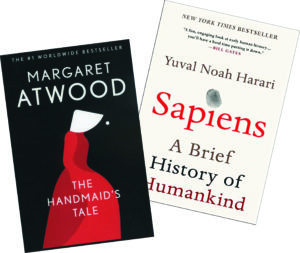PUBLISHED JULY/AUGUST 2019
by
Cathi Stevenson, Owner, Book Cover Express --
 Cathi Stevenson
Cathi StevensonMany books make the bestsellers' lists with text-only covers. Not only is an image-free cover possible, it's often preferable.
Not all books, particularly nonfiction genres, lend themselves to a single image. We've all seen book covers with irrelevant images on them, or images that portray the title of the book literally, but not the content.
Finding appropriate stock images can be time consuming. If you've ever read the licensing agreement on a stock image site, chances are you ended up with more questions than you started with. And then there's the countless hours spent searching for the right image or images. Then more hours-even days-dedicated to incorporating the chosen image(s) into the cover design. There's even the chance you'll end up scrapping the whole idea to start over with a different image. While stock images offer an affordable and convenient alternative to hiring an illustrator or photographer, they're often not all that convenient, or even very affordable.
So why not brand your title and make it do all the work? It certainly paid off for
White Teeth by Zadie Smith (Vintage, 2001). The paperback release of
White Teeth included a large, sans serif title on a solid background and offered consumers a choice of several colors. It's since been released with many different designs all over the world, but none seem to have the impact of the originals.
Facism: A Warning by Madeleine Albright (HarperCollins, 2018) was No. 1 on The
New York Times Best Seller list and named Best Book of 2018 by
The Economist, all while proudly wrapped in a text-only cover set on a background with a very subtle stone texture that couldn't even be seen at thumbnail.
If you're not quite ready to embrace a cover with nothing but the title to intrigue readers, why not make the title itself the art? The paperback version of Augusten Burrough's memoir
Dry (Picador, 2004) has text that appears to be smeared or running, as if the ink isn't dry. A simple play on words from well-known book cover design Chip Kidd that made quite an impact. The same title treatment was used for the 10th anniversary edition.
 Sapiens: A Brief History of Mankind by Yuval Harari and The Handmaid's Tale by Margaret Atwood
Sapiens: A Brief History of Mankind by Yuval Harari and The Handmaid's Tale by Margaret Atwood by James Clear (Avery, 2018) has enjoyed time on all the major bestsellers' lists. Again, the text is the image, with small gold squares or "particles" that appear to be coming together to form the title. This works well as a teaser, forcing readers to go to the subtitle for an explanation.
Simple shapes are another alternative. Consider the single small fingerprint on Yuval Noah Harari's
Sapiens: A Brief History of Humankind (Harper Perennial, 2018), or the "bubbles" on Victoria Moore's
How to Drink (hardcover, Andrews McMeel Publishing, 2009; paperback, Granta Books, 2001). And don't forget the simple cloak silhouette that has become an icon for Margaret Atwood's
The Handmaid's Tale.
Without a feature image taking center stage, you'll have plenty of room to make sure your title can be read when reduced to thumbnail. You can add a quote, a better longer subtitle, make the author's name larger, or even put it on two lines to better brand the author. Text-only covers might also increase shelf life. Hairstyles, clothing, electronics-even furniture and makeup-change from one year to the next. And some elements, such as the age or race of a model, or even a landmark, always have the potential of alienating potential readers who don't see themselves in that demographic.
 (1) Low contrast between elements can hamper the ease of reading.
(1) Low contrast between elements can hamper the ease of reading.
(2) Visual vibration is an unpleasant effect of brightly colored text on a bright background.
(3)Some colors, like red, can deteriorate when uploaded to social media
There are caveats, though. Text-only covers can seem easy to create, but that's not always the case. Fonts and colors became more important. Kerning and leading need to be perfect, because they're now center stage. The shape of each letterform requires attention. Manual adjustments will almost certainly be necessary.
You'll also need to make sure the fonts are representative of the genre and will appeal to your target audience. Informal handwriting fonts might work well for some books, but if the subject is the history of finance, you're going to want a more traditional font. A
2012 study in The
New York Times revealed that readers found an article set in Baskerville more credible than the same article set in Computer Modern, Georgia, Helvetica, Comic Sans, or Trebuchet. Some fonts work better for people with vision challenges, including dyslexia and presbyopia (a condition most people develop as they age, necessitating reading glasses). It's important for publishers and those working for them to do their research and be knowledgeable about these things.
Special attention also needs to be paid to color. Color can wreak havoc with online sales, and visual vibration-an unpleasant effect that occurs when you put brightly colored text on a bright background-needs to be avoided. And keep in mind that your cover image will be automatically optimized on social media platforms where some colors, especially red, can deteriorate significantly, creating distracting halos around text edges. Computer glare and low contrast between elements can also hamper ease of reading. You can learn more about contrast and check color combinations for free
here. While this site focuses on online visibility, it should be noted that contrast is just as important in print.
Text-only covers won't work for all books, but keep an open mind. You might be surprised by how powerful the right font and design can be.
Cathi Stevenson is the owner of BookCoverExpress.com,
an award-winning book design business that has been in operation since 1999. Since opening, she has created about 2,500 book covers for indie authors, self-publishers, small presses, university presses, larger publishing companies, life coaches, business professionals, and corporations. Nonfiction book cover design is her specialty, but she also designs fiction book covers. Book Cover Express clients have been featured in numerous high-profile media sources including Oprah, 48-Hours, People Magazine,
and The Today Show.
Want more tips to help you design an award-winning cover for your books? Check out this article from IBPA Independent, "
Converting Book Browsers to Book Buyers".